

NLnet Labs DNSSEC workshop Website. Net Programming Guide. Setting a Static IP. It is very important to setup a static ip address, if you are going to use port forwarding.

When you have port forwarding setup, your router forwards ports to an ip address that you specify. This will probably work when you initially set it up, but after restarting your computer it may get a different ip address. Multiple Sites : One Server. This document attempts to answer the commonly-asked questions about setting up virtual hosts.
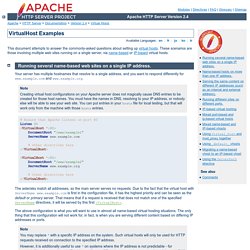
These scenarios are those involving multiple web sites running on a single server, via name-based or IP-based virtual hosts. Running several name-based web sites on a single IP address. Your server has multiple hostnames that resolve to a single address, and you want to respond differently for www.example.com and www.example.org. Note Creating virtual host configurations on your Apache server does not magically cause DNS entries to be created for those host names. . # Ensure that Apache listens on port 80Listen 80<VirtualHost *:80> DocumentRoot "/www/example1" ServerName www.example.com # Other directives here</VirtualHost><VirtualHost *:80> DocumentRoot "/www/example2" ServerName www.example.org # Other directives here</VirtualHost> The asterisks match all addresses, so the main server serves no requests. IP Subnetting.
This page will give you a basic understanding of the structure of IP addresses and subnets at Cornell.

What Are IP Addresses and How Are They Used? IP (Internet Protocol) addresses are used to identify hosts on the campus network that in turn ties into the Internet, a global network. A networked computer must have an IP address assigned to the computer to be recognized as part of the network. IP addresses are constructed according to a set of specific rules so that hosts on any part of the Internet can communicate with each other. This document describes IP addresses only as they apply to Cornell's campus network. An IP address consists of a 32-bit binary number, which is typically presented as four decimal numbers (one for each 8-bit byte) separated by decimal points. Internet addresses at Cornell have three parts: Network Address. Internet protocol suite. The Internet protocol suite is the computer networking model and set of communications protocols used on the Internet and similar computer networks.
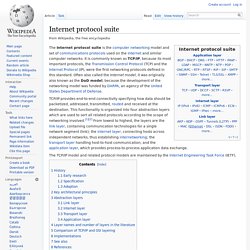
It is commonly known as TCP/IP, because its most important protocols, the Transmission Control Protocol (TCP) and the Internet Protocol (IP), were the first networking protocols defined in this standard. Often also called the Internet model, it was originally also known as the DoD model, because the development of the networking model was funded by DARPA, an agency of the United States Department of Defense. TCP/IP provides end-to-end connectivity specifying how data should be packetized, addressed, transmitted, routed and received at the destination. The TCP/IP model and related protocol models are maintained by the Internet Engineering Task Force (IETF). History[edit] Early research[edit] Communications protocol. In telecommunications, a communications protocol is a system of digital rules for data exchange within or between computers.
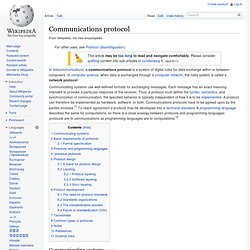
In computer science, when data is exchanged through a computer network, the rules system is called a network protocol. Communicating systems use well-defined formats for exchanging messages. Each message has an exact meaning intended to provoke a particular response of the receiver. Thus, a protocol must define the syntax, semantics, and synchronization of communication; the specified behavior is typically independent of how it is to be implemented. A protocol can therefore be implemented as hardware, software, or both. Communicating systems[edit] In digital computing systems, the rules can be expressed by algorithms and data structures.
Computer Networking. Computer networks differ in the physical media used to transmit their signals, the communications protocols to organize network traffic, the network's size, topology and organizational intent.
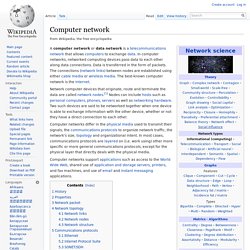
In most cases, communications protocols are layered on (i.e. work using) other more specific or more general communications protocols, except for the physical layer that directly deals with the physical media. Computer networks support applications such as access to the World Wide Web, shared use of application and storage servers, printers, and fax machines, and use of email and instant messaging applications. History[edit] How TCP/IP Works. When transmitting data, the Transport layer gets data from the Application layer and divides them into several data packets.

TCP (Transmission Control Protocol) is the most used protocol on the Transport layer. When receiving data, TCP protocol gets the packets sent by the Internet layer and put them in order, because packets can arrive at the destination out-of-order, and also checks if the contents of the received packet are intact and sends an acknowledge signal to the transmitter, allowing it to know that the packet arrived intact at destination.
If no acknowledge signal is received (either because it didn’t arrive the destination or because TCP found out that data was corrupted), the transmitter will re-send the lost packet. While TCP re-orders packets and also uses this acknowledge system we mention, which is desirable when transmitting data, there is another protocol that works on this layer that does not have these two features. The TCP/IP Guide. I know everyone hates ads.
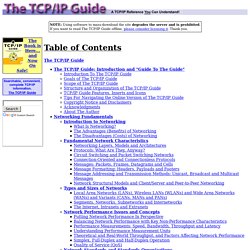
But please understand that I am providing premium content for free that takes hundreds of hours of time to research and write. I don't want to go to a pay-only model like some sites, but when more and more people block ads, I end up working for free. And I have a family to support, just like you. :) Types of Network Protocols. What is a Network Protocol A protocol is a set of rules that govern the communications between computers on a network.
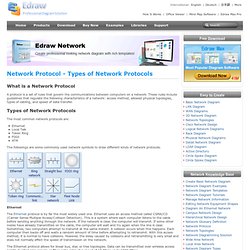
These rules include guidelines that regulate the following characteristics of a network: access method, allowed physical topologies, types of cabling, and speed of data transfer.